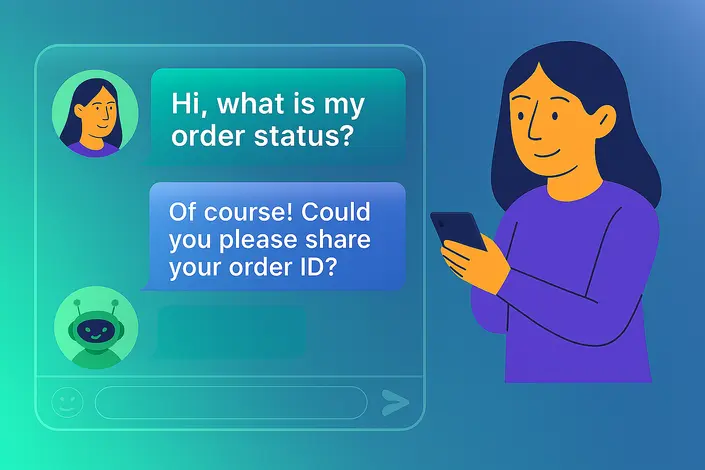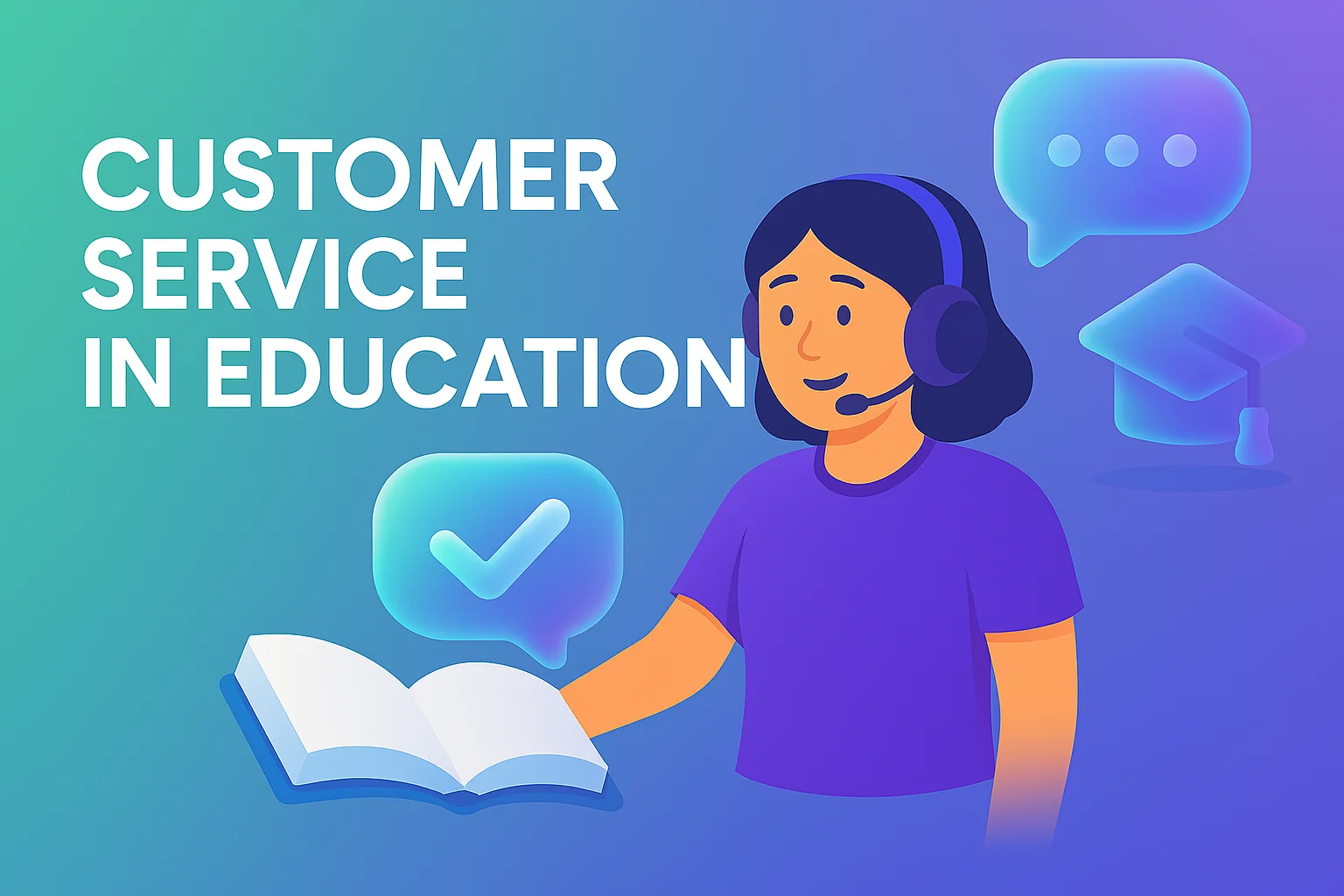Collecting Customer Data – 8 Effective Methods and Ways
- May 8, 2023
- 13 mins read
- Listen

Data-driven organizations are more profitable and more successful than others. They are also likely to acquire and retain more customers. With customer data, a business can find it easy to know the demographics and preferences of the target market.
In addition, data can help personalize the customer’s experiences and gain a competitive advantage. By collecting and analyzing customer data, companies are able to create targeted marketing campaigns and offer customized products and services.
What’s more, organizations that collect customer data deliver excellent experiences and therefore can witness an improved customer satisfaction rate. When customers are happy and satisfied, it helps companies improve their bottom line.
In this blog post, we will explore the various key things related to the practice of collecting customer data and also understand different ways to collect the data.
But first, let’s get started with understanding why to collect customer data.
Collecting Customer Data – The Interesting Stats
A growing number of businesses make it a point to collect and analyze customer data as they know the value of doing that. Across industries, more brands now give customer data a preference.
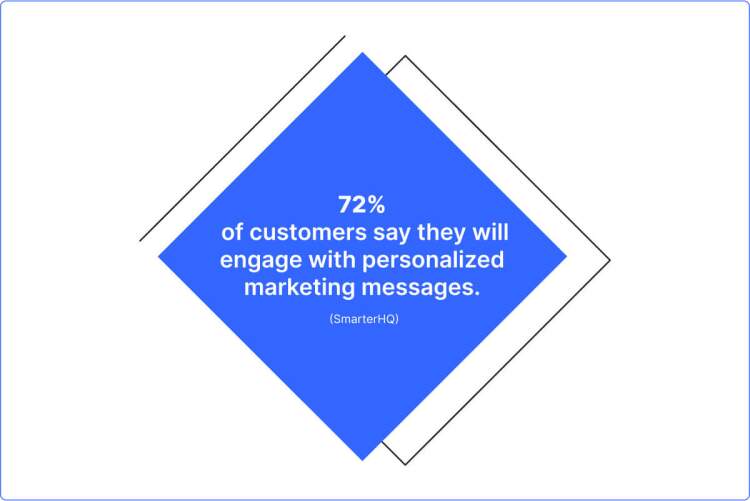
Let’s have a look at some key stats regarding the same –
- 72% of customers say they will engage with personalized marketing messages. (SmarterHQ)
Personalization is key in marketing and a business can never create personalized marketing messages unless it collects customer data.
- 86% of customers are willing to pay more for a better customer experience. (Oracle)
Without data, it’s never possible for any business to provide better service.
- Nine out of 10 customers will shop with brands that provide relevant offers and recommendations. (Accenture)
Offering relevant recommendations is possible only when a business gathers and analyzes customer data.
- 87% of businesses that use data analytics to make decisions easily exceed their revenue targets. (Forbes)
Only data can help brands in making good decisions.
Why Should a Business Collect Customer Data?
Collecting customer data can help businesses in many ways. The best way it can help is it will give a good understanding of the customers. By understanding customers well, a business can cater to their needs and preferences, resulting in a positive impact on the bottom line.
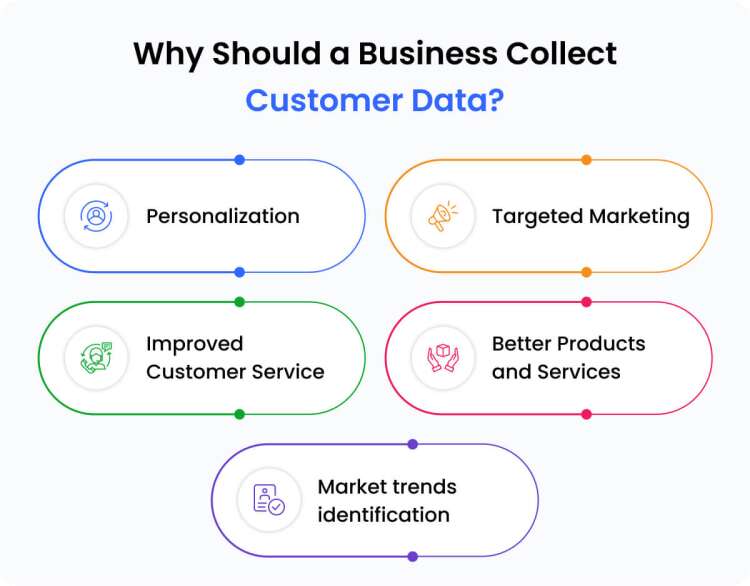
There are many reasons why a business should collect customer data –
- Personalization – Companies collect customer data to understand their customers better, know their behaviors and needs and then personalize the experiences. Only data can help in tailoring products and services to better meet the customers’ expectations.
- Targeted Marketing – Creating more effective marketing messages is possible only when a company collects customer data. By analyzing the data, it becomes easy to identify the trends and patterns in customer behavior and use the information for effective marketing campaigns.
- Improved Customer Service – When a business tracks customer interactions and feedback, it’s always in a good position to identify the gaps existing between what customers want and what they get. The use of data can help a lot in making changes to products, resulting in improved experiences for customers.
- Better Products and Services – Regularly collecting data and analyzing customer feedback can assist businesses in making improvements to their product development efforts. This results in better products, services, and features for customers.
- Market Trends identification – Data is always the key when it comes to identifying marketing trends and changes more quickly. When a business is data-driven, it can respond more effectively to the changes around it.
Tips to Collect Customer Data for Direct Marketing
We know there are many benefits to collecting customer data. The more data a business collects, the better customer insight it has. The trick is to be aware of the right methods and ways for gathering data and leveraging analytics.
Here are some of the popular ways to collect customer data for direct marketing –
1. Surveys
Surveys have always been one of the best and most efficient ways to collect customer data for marketing purposes. They are also a great way to learn about your existing customers and prospects.
One of the key aspects of surveys is you can create them in many ways and at different levels. You can use a survey to collect feedback for customers purchasing your products or service.
A survey can also be used for users signing up for your email newsletter or for those who are navigating your website. A good survey includes all the important questions that help a business learn more about its customers.
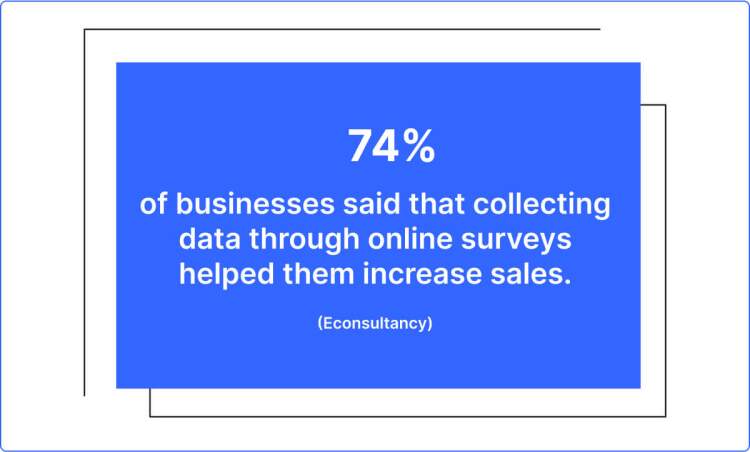
How to conduct surveys?
- Before creating a survey, it’s vital to define the purpose and the target audience and then prepare the right questions.
- You need to decide whether you want to conduct the surveys online, via phone, or via email, to get the right responses from the target audience.
- Create a list of questions in tune with the survey goals and then test the survey with a small group of people before launching it.
- You can launch the survey and collect useful customer data.
2. Web Tracking
Websites are very helpful when it comes to collecting customer data for marketing and research purposes. They also serve a big purpose in customer engagement. Many companies use the website to gather useful data about their customers and serve them better. When customers visit a website, they leave behind different types of data that can offer key insight into them.
Based on the website visit, you can know many things, including –
- How customers reached there?
- What source did they use to reach there?
- How long did they stay on the site?
- How many pages did they visit?
- What did they do on the website?
This kind of tracking proves very helpful in improving your website’s user experience and optimizing marketing campaigns.
Steps with web tracking
- Define the objective and goals you want to achieve with a web tracking or customer insight tool as what information you want to collect and how to use it.
- Based on the objective, you can choose the right tracking methods and tools.
- You can use cookies, log files, or pixels as methods for web tracking and collecting useful customer data.
- Select and configure a web analytics tool on your website such as Google Analytics, to meet your tracking goals.
- You can now track many different types of data such as clicks, page views, and conversion rates, and understand user behavior better.
3. Social Media
Social media is now a great tool to collect a lot of customer data legally and make your marketing effort more valuable. You can track a variety of people there, from those following your brand to those liking your pages and those commenting or engaging in conversations. Be it Facebook or Instagram or any other social media channel, you can leverage any of them and gather tons of useful information about customers.
With social media, you can track both qualitative and quantitative data by using the shares, follows, likes, reviews, and other content. What’s more, most social platforms come equipped with audience insights features that can give a good insight into their activity, demographics, and behavior.
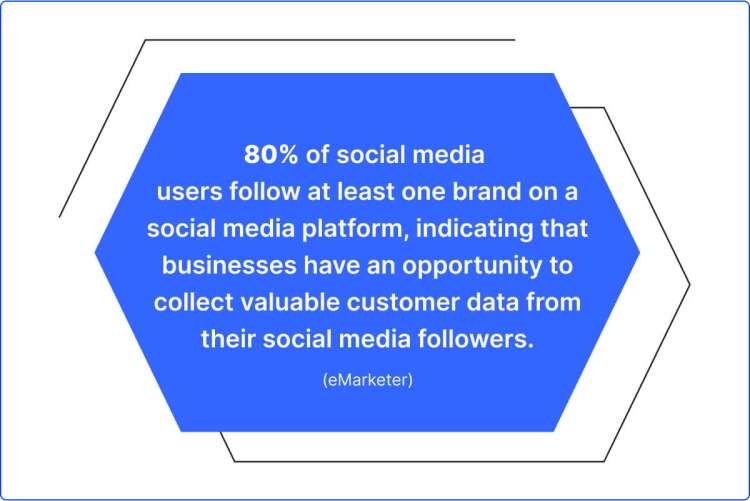
Steps with data collection via social media
- Identify your goals and then select the relevant social media channel ( Twitter, LinkedIn, Facebook, Instagram) based on the industry and audience.
- Choose the data collection method whether you want to use monitoring tools, or surveys or just want to rely on social listening.
- Collect the data by defining the specific metrics and KPIs to better utilize the information.
4. Chatbots
Chatbots have emerged as wonderful tools for collecting user data for marketing and conversions. Many companies now use AI-powered bots throughout their website to gather useful customer data and ensure effective marketing campaigns.
Since chatbots are advanced today, they can interact with customers, engage them and provide answers to their questions. This engagement can help in learning about customers’ demographic, preferences, pain points, etc.
The primary focus of using a chatbot is to know what information customers are searching for on the website. This information can be used to serve customers better and improve their experience with your brand.
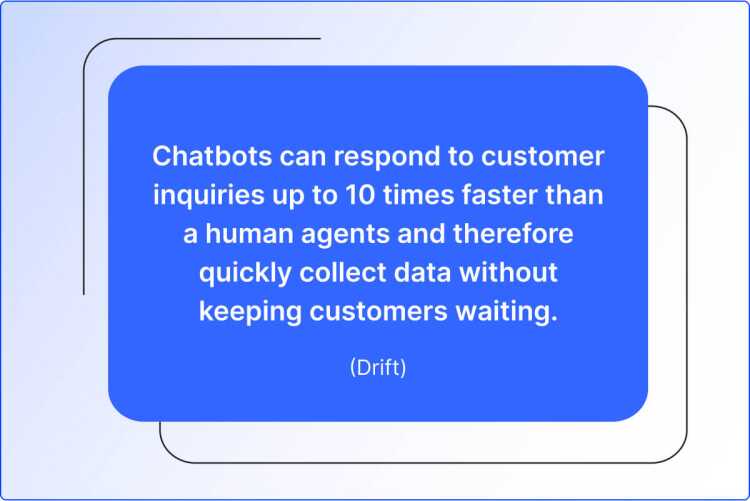
How does a chatbot collect customer data?
- Chatbots on a website can interact with customers, ask them to fill out a survey and collect data about their age, gender, location, interest, and experiences.
- AI chatbots can do automated data collection when they are programmed and this way they can customer data without needing human touch.
- Chatbots that are developed with natural language processing (NLP) technology capabilities can understand and interpret human responses easily.
- Bots can use the past data and previous records of customers to personalize the conversation.
5. Transactional Data
A business collects transactional data every time someone makes a purchase. This data can include useful information on purchase history, product preferences, and transaction amounts.
In addition, when customers transact on a website, they also leave behind the keywords and other key info such as whether they used a coupon code, what other products they showed interest in, etc.
All this useful information can be used to re-target customers, and also in making decisions about products and sales.
What makes transaction data helpful?
- This data is more accurate compared to other forms because it comes from the transaction itself, so the chances of errors are very minimal.
- Such data is generated and collected in real-time when customers engage with the business, so it can be relied on for making informed decisions.
- Transaction data is relevant as it offers insights into customers’ buying preferences and behavior.
- This data is actionable as a business can use them to personalize customer interactions and offer recommendations.
6. Email Newsletters
Creating and sending email newsletters can be a great way to collect customer data. This way, a business can engage and communicate with customers and get valuable information in exchange for content. When a customer signs up for the newsletter, they need to give their email address which they can use for sharing offers and marketing messages.
Once the customer’s email address is available, a brand can reach out to them and get useful information regarding the type of content, products, and services they would like. A newsletter can also be used to run surveys and increase customer engagement.
Steps with using newsletters for data collection
- Create a sign-up form and then display it on the website or social media profile.
- Keep the form easy and simple so that customers feel encouraged to provide the information your business needs.
- Give customers reasons or incentives to sign up else they might not feel tempted to share the information.
- Keep your subscribers engaged by sending regular newsletters and by ensuring them valuable content from time to time.
7. Customer Service Interactions
Interactions with customers can be an excellent tool for collecting useful data. This way, businesses can collect specific data points they want to collect. From demographic information to product or service preferences, agents can interact with customers and get relevant data for the business.
How to use customer service interactions for data?
- Train your customer service team on how to collect the data effectively and also give them a script that includes the questions they should ask customers.
- Equip your team with the right engagement tools such as AI chatbot and live chat so that interactions become prompt.
- Store and manage customer data in CRM software as it will help personalize customer interactions in the future.
- Analyze the data to identify patterns and trends so that your business can improve the product and service and also deliver quality experiences to customers.
8. Loyalty Programs
Customers are more likely to share information when there are rewards and benefits. If a business offers incentives to customers or uses loyalty programs, it can get useful customer data. Many businesses offer customers some reward for signing up for their loyalty programs. This motivates customers to offer their contact information.
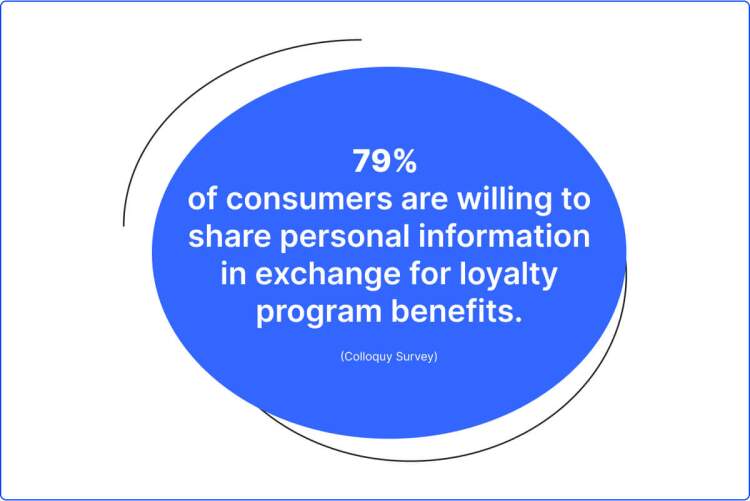
Once customers sign up, a business can always request additional information to personalize their experience. More importantly, loyalty programs can also be used to track customer behavior and the data gained can help in devising marketing and business strategies.
The data collected from using loyalty programs can also be used to improve customer experiences. It can also serve as a tool to provide personalized communication and offer relevant products and services.
Make Your Customer Data Collection System Efficient with REVE Chat
It takes the support of the right tools and technology to gather and analyze customer data. We, at REVE Chat, are aware of the challenges involved with data collection and that’s why we strive to ease the worries of businesses.
Our engagement tools can help a lot in collecting the data quickly and ensuring value to customers at each stage of the journey. With our AI-powered chatbots, an organization can automate responses and offer quick answers to queries, resulting in valuable data on customers’ preferences and behavior.
In addition, we have video chat and co-browsing software as well that not only increase the value of support for your customers but also help gather vital information along the way.
Our live chat software can be paired with the chatbot to offer hybrid support and enhance the customer’s overall experience with the brand.
Final Thoughts
Customer data has a big role to play in ensuring efficiency and success with marketing messages and campaigns. If a business uses the right tools and technology, it can not only collect valuable customer data but can also improve service delivery.
You can sign up with us and check some of the best customer support tools available in the industry.
Using our tools, you can gather and analyze data on any scale and achieve the desired goals with marketing.

